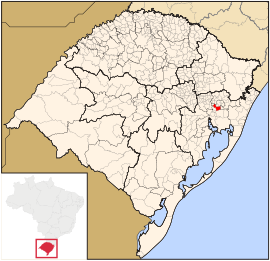Novo Hamburgo
| Novo Hamburgo | ||
|---|---|---|
|
Coordinates: 29 ° 41 ′ S , 51 ° 8 ′ W Novo Hamburgo on the map of Brazil
|
||
| Basic data | ||
| Country | Brazil | |
| State | Rio Grande do Sul | |
| City foundation | April 5, 1927 | |
| Residents | 246,452 ( ber . 2018) | |
| City insignia | ||
| Detailed data | ||
| surface | 224 km 2 | |
| Population density | 1157 inhabitants / km 2 | |
| height | 57 m | |
| Waters | Rio dos Sinos | |
| Time zone | UTC −3 | |
| City Presidency | Tarcísio Zimmermann ( PT ) | |
| Website | ||
| Location of Novo Hamburgo in Rio Grande do Sul | ||
| Casa Schmitt-Presser | ||
Novo Hamburgo ( New Hamburg ) is the northernmost city of the Região Metropolitana de Porto Alegre in the southernmost Brazilian state of Rio Grande do Sul . The city has around 250,000 inhabitants. Like Franca , it describes itself as the “capital of the shoe” (Portuguese: “Capital Nacional do Calçado”).
geography
Novo Hamburgo is 45 kilometers north of Porto Alegre and 80 kilometers south of Caxias do Sul . The city lies in the valley of the Rio dos Sinos . The Serra Gaúcha begins north of it .
The city borders on Campo Bom , Dois Irmãos , Estância Velha , Gravataí , Ivoti , Sapiranga , São Leopoldo and Taquara .
The city extends over 217 km². The climate is subtropical with an average annual temperature of 19 ° C.
history
The first inhabitants in the 18th century were Azoreans who settled in the Rincão dos Ilhéus district. From 1824 German immigrants came to São Leopoldo , a first rural center was built on Hamburgerberg, the core of today's city. After that, more and more English came to the city and built a railway line in 1870.
Novo Hamburgo was not settled by hamburgers, but more by Hunsrückers . However, Hamburg was the common port of embarkation for the German settlers. Novo Hamburgo was founded as a city in 1927.
After Brazil entered the war in 1944, the city was renamed Marechal Floriano Peixoto .
Diocese of Novo Hamburgo
The city is the seat of the Diocese of Novo Hamburgo , whose episcopal church is the São Luís Gonzaga Cathedral .
economy
Novo Hamburgo is now an industrial city, consisting mainly of tanneries and shoe factories. The leather industry has been in crisis since the 1990s due to imports from countries such as China. Diversification has taken place since then. Lured by potential jobs, many poor people came from other parts of Brazil, causing problems such as slum formation and a lack of infrastructure.
Worth seeing
In the Hamburgo Velho district (formerly Hamburgerberg ) there are still some old buildings. The museum for the painter and sculptor Ernesto Frederico Scheffel in a house from 1890 is not only interesting as a building. Next to it is the oldest preserved building in the city, Casa Schmitt-Presser , a half-timbered house from 1831. The Museu Nacional do Calçado shoe museum is also located on Hamburgerberg .
Surroundings
In the nearby small towns of Ivotí , Dois Irmãos and Sapiranga , there is good access to small rivers with waterfalls and to mountains with remains of primeval forest. The highest waterfall with a height of over 100 m can be found near Santa Maria do Herval . There and in small settlements like Frankenberg or Muckerberg, German is still the colloquial language today ( Riograndenser Hunsrückisch ).
sons and daughters of the town
- Jakobine Maurer (1841 / 42–1874), sect leader
- Catherrine Leclery (* 1969), drag queen living in Germany
- Daniela Lanner Mapeli (* 1975), volleyball player
- Maicon Douglas Sisenando ( Maicon ; * 1981), national soccer player
- Bárbara Arenhart (* 1986), handball player
- Frederico Burgel Xavier (* 1986), football player
- Muriel Becker (* 1987), soccer goalkeeper
- César Ramos (* 1989), racing driver
- Alisson Becker (* 1992), soccer goalkeeper
- Matheus Leist (* 1998), racing driver
Web links
- Novo Hamburgo City Council website (Portuguese)
Individual evidence
- ↑ a b Brazilian Institute of Geography and Statistics (PDF) 2018. Retrieved on March 6, 2019: "2018 Estimates of Population"



